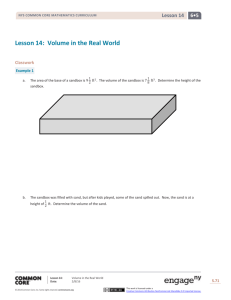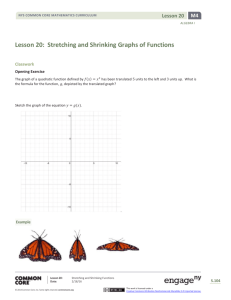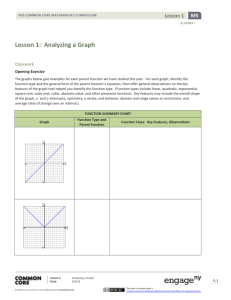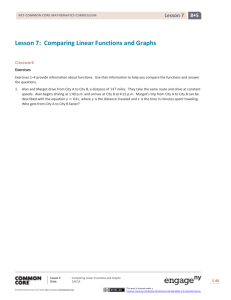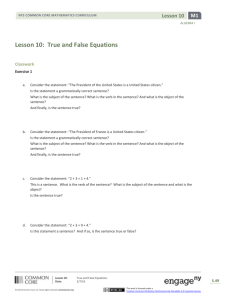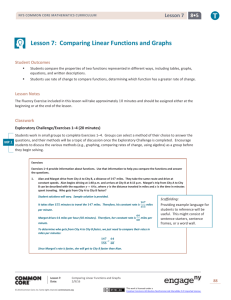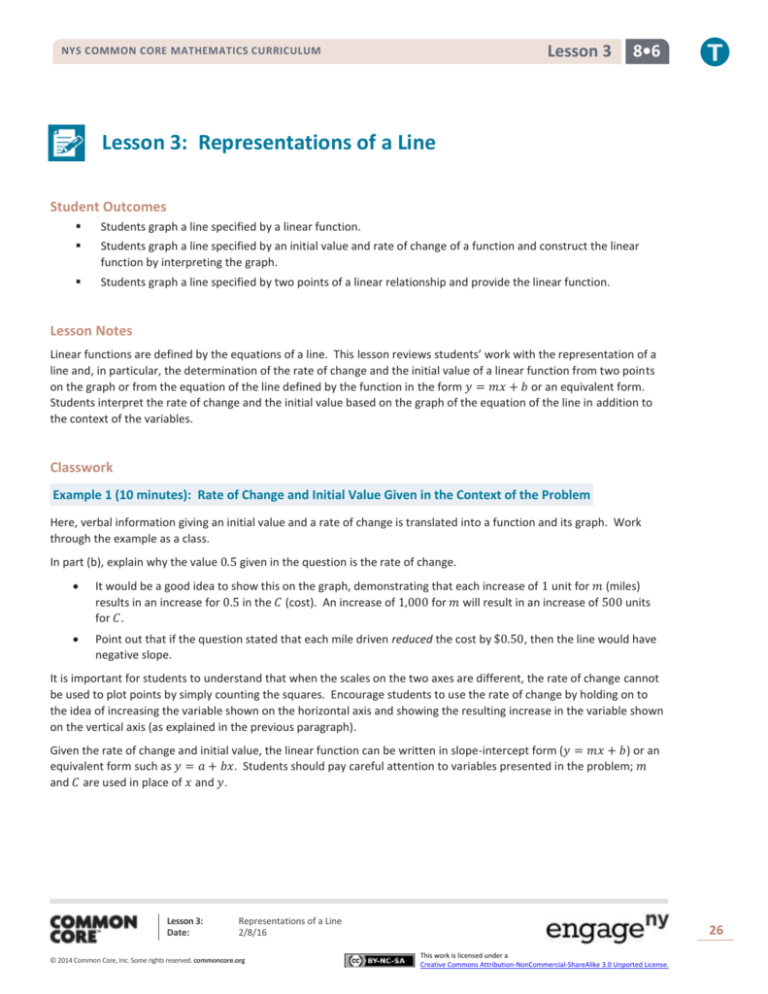
Lesson 3
NYS COMMON CORE MATHEMATICS CURRICULUM
8•6
Lesson 3: Representations of a Line
Student Outcomes
Students graph a line specified by a linear function.
Students graph a line specified by an initial value and rate of change of a function and construct the linear
function by interpreting the graph.
Students graph a line specified by two points of a linear relationship and provide the linear function.
Lesson Notes
Linear functions are defined by the equations of a line. This lesson reviews students’ work with the representation of a
line and, in particular, the determination of the rate of change and the initial value of a linear function from two points
on the graph or from the equation of the line defined by the function in the form 𝑦 = 𝑚𝑥 + 𝑏 or an equivalent form.
Students interpret the rate of change and the initial value based on the graph of the equation of the line in addition to
the context of the variables.
Classwork
Example 1 (10 minutes): Rate of Change and Initial Value Given in the Context of the Problem
Here, verbal information giving an initial value and a rate of change is translated into a function and its graph. Work
through the example as a class.
In part (b), explain why the value 0.5 given in the question is the rate of change.
It would be a good idea to show this on the graph, demonstrating that each increase of 1 unit for 𝑚 (miles)
results in an increase for 0.5 in the 𝐶 (cost). An increase of 1,000 for 𝑚 will result in an increase of 500 units
for 𝐶.
Point out that if the question stated that each mile driven reduced the cost by $0.50, then the line would have
negative slope.
It is important for students to understand that when the scales on the two axes are different, the rate of change cannot
be used to plot points by simply counting the squares. Encourage students to use the rate of change by holding on to
the idea of increasing the variable shown on the horizontal axis and showing the resulting increase in the variable shown
on the vertical axis (as explained in the previous paragraph).
Given the rate of change and initial value, the linear function can be written in slope-intercept form (𝑦 = 𝑚𝑥 + 𝑏) or an
equivalent form such as 𝑦 = 𝑎 + 𝑏𝑥. Students should pay careful attention to variables presented in the problem; 𝑚
and 𝐶 are used in place of 𝑥 and 𝑦.
Lesson 3:
Date:
Representations of a Line
2/8/16
© 2014 Common Core, Inc. Some rights reserved. commoncore.org
26
This work is licensed under a
Creative Commons Attribution-NonCommercial-ShareAlike 3.0 Unported License.
Lesson 3
NYS COMMON CORE MATHEMATICS CURRICULUM
8•6
Example 1: Rate of Change and Initial Value Given in the Context of the Problem
A truck rental company charges a $𝟏𝟓𝟎 rental fee in addition to a charge of $𝟎. 𝟓𝟎 per mile driven. In this problem, you
will graph the linear function relating the total cost of the rental in dollars, 𝑪, to the number of miles driven, 𝒎, on the
axes below.
a.
If the truck is driven 𝟎 miles, what will be the cost to the customer? How will this be shown on the graph?
$𝟏𝟓𝟎, shown as the point (𝟎, 𝟏𝟓𝟎). This is the initial value. Some students might say “𝒃.” Help them to use
the term “initial value.”
b.
What is the rate of change that relates cost to number of miles driven? Explain what it means within the
context of the problem.
The rate of change is 𝟎. 𝟓. It means that the cost will increase by $𝟎. 𝟓𝟎 for every mile driven.
c.
On the axes given, sketch the graph of the linear function that relates 𝑪 to 𝒎.
Students can plot the initial value (𝟎, 𝟏𝟓𝟎) and then use the rate of change to identify additional points as
needed. A 𝟏, 𝟎𝟎𝟎 unit increase in 𝒎 results in a 𝟓𝟎𝟎 unit increase for 𝑪, so another point on the line is
(𝟏𝟎𝟎𝟎, 𝟔𝟓𝟎).
d.
Write the equation of the linear function that models the relationship between number of miles driven and
total rental cost.
𝑪 = 𝟎. 𝟓𝒎 + 𝟏𝟓𝟎
Exercises 1–5 (10 minutes)
Here, students have an opportunity to practice the ideas to which they have just been introduced. Let students work
independently on these exercises. Then, discuss and confirm answers as a class.
Exercise 3, part (c) provides an excellent opportunity for discussion about the model and whether or not it continues to
make sense over time.
In Exercise 3, you found that the price of the car in year seven was less than $600. Does this make sense in
general?
Not really.
Under what conditions might the car be worth less than $600 after seven years?
The car may have been in an accident or damaged.
Lesson 3:
Date:
Representations of a Line
2/8/16
© 2014 Common Core, Inc. Some rights reserved. commoncore.org
27
This work is licensed under a
Creative Commons Attribution-NonCommercial-ShareAlike 3.0 Unported License.
Lesson 3
NYS COMMON CORE MATHEMATICS CURRICULUM
8•6
Exercises
Value of the Car in Dollars
Jenna bought a used car for $𝟏𝟖, 𝟎𝟎𝟎. She has been told that the value of the car is likely to decrease by $𝟐, 𝟓𝟎𝟎 for each
year that she owns the car. Let the value of the car in dollars be 𝑽 and the number of years Jenna has owned the car be 𝒕.
Number of Years
1.
What is the value of the car when 𝒕 = 𝟎? Show this point on the graph.
$𝟏𝟖, 𝟎𝟎𝟎. Shown by the point (𝟎, 𝟏𝟖𝟎𝟎𝟎).
2.
What is the rate of change that relates 𝑽 to 𝒕? (Hint: Is it positive or negative? How can you tell?)
−𝟐, 𝟓𝟎𝟎. The rate of change is negative because the value of the car is decreasing.
3.
Find the value of the car when
a.
𝒕 = 𝟏.
𝟏𝟖𝟎𝟎𝟎 − 𝟐𝟓𝟎𝟎 = $𝟏𝟓𝟓𝟎𝟎
b.
𝒕 = 𝟐.
𝟏𝟖𝟎𝟎𝟎 − 𝟐(𝟐𝟓𝟎𝟎) = $𝟏𝟑𝟎𝟎𝟎
c.
𝒕 = 𝟕.
𝟏𝟖𝟎𝟎𝟎 − 𝟕(𝟐𝟓𝟎𝟎) = $𝟓𝟎𝟎
4.
Plot the points for the values you found in Exercise 3, and draw the line (using a straight-edge) that passes through
those points.
See graph above.
5.
MP.7
Write the linear function that models the relationship between the number of years Jenna has owned the car and
the value of the car.
𝑽 = 𝟏𝟖𝟎𝟎𝟎 − 𝟐𝟓𝟎𝟎𝒕 or 𝑽 = −𝟐, 𝟓𝟎𝟎𝒕 + 𝟏𝟖𝟎𝟎𝟎
Exercises 6–10 (10 minutes)
Here, in the context of the pricing of a book, students are given two points on the graph of a linear equation and are
expected to draw the graph, determine the rate of change, and answer questions by referring to the graph.
Lesson 3:
Date:
Representations of a Line
2/8/16
© 2014 Common Core, Inc. Some rights reserved. commoncore.org
28
This work is licensed under a
Creative Commons Attribution-NonCommercial-ShareAlike 3.0 Unported License.
Lesson 3
NYS COMMON CORE MATHEMATICS CURRICULUM
8•6
Point out that the horizontal axis does not start at 0. Ask students the following question:
Why do you think the first value is at 15?
The online bookseller may not sell the book for less than $15.
In Exercise 8, students are asked to find the rate of change; it might be worthwhile to check that they are using the
scales on the axes, not purely counting squares.
For Exercises 9 and 10, encourage students to show their work by drawing vertical and horizontal lines on the graph, as
shown in the sample student answers below.
Let students work with a partner. Then, discuss and confirm answers as a class.
An online bookseller has a new book in print. The company estimates that if the book is priced at $𝟏𝟓, then 𝟖𝟎𝟎 copies
of the book will be sold per day, and if the book is priced at $𝟐𝟎, then 𝟓𝟓𝟎 copies of the book will be sold per day.
6.
Identify the ordered pairs given in the problem. Then, plot both on the graph.
The ordered pairs are (𝟏𝟓, 𝟖𝟎𝟎) and (𝟐𝟎, 𝟓𝟓𝟎). See graph above.
7.
Assume that the relationship between the number of books sold and the price is linear. (In other words, assume
that the graph is a straight line.) Using a straight-edge, draw the line that passes through the two points.
See graph above.
8.
What is the rate of change relating number of copies sold to price?
Between the points (𝟏𝟓, 𝟖𝟎𝟎) and (𝟐𝟎, 𝟓𝟓𝟎), the run is 𝟓 and the rise is −(𝟖𝟎𝟎 − 𝟓𝟓𝟎) = −𝟐𝟓𝟎. So, the rate of
change is
9.
−𝟐𝟓𝟎
= −𝟓𝟎.
𝟓𝟎
Based on the graph, if the company prices the book at $𝟏𝟖, about how many copies of the book can they expect to
sell per day?
𝟔𝟓𝟎
10. Based on the graph, approximately what price should the company charge in order to sell 𝟕𝟎𝟎 copies of the book
per day?
$𝟏𝟕
Lesson 3:
Date:
Representations of a Line
2/8/16
© 2014 Common Core, Inc. Some rights reserved. commoncore.org
29
This work is licensed under a
Creative Commons Attribution-NonCommercial-ShareAlike 3.0 Unported License.
Lesson 3
NYS COMMON CORE MATHEMATICS CURRICULUM
8•6
Closing (5 minutes)
If time allows, consider posing the following questions:
How would you interpret the meaning of the rate of change (−50) from Exercise 8?
Does it seem reasonable that the number of copies sold would decrease with respect to an increase in price?
Answers will vary; pay careful attention to wording. The number of copies sold would decrease by 50
units as the price increased by $1, or for every dollar increase in the price, the number of copies sold
would decrease by 50 units.
Yes, if the book was really expensive, someone may not want to buy it. If the cost remained low, it
seems reasonable that more people would want to buy it.
How is the information given in the truck rental problem different than the information given in the book
pricing problem?
In the book pricing problem, the information was given as ordered pairs. In the truck rental problem,
the information was given in the form of a slope and initial value.
Lesson Summary
When the rate of change, 𝒃, and an initial value, 𝒂, are given in the context of a problem, the linear function that
models the situation is given by the equation 𝒚 = 𝒂 + 𝒃𝒙.
The rate of change and initial value can also be used to sketch the graph of the linear function that models the
situation.
When two or more ordered pairs are given in the context of a problem that involves a linear relationship, the graph
of the linear function is the line that passes through those points. The linear function can be represented by the
equation of that line.
Exit Ticket (10 minutes)
Lesson 3:
Date:
Representations of a Line
2/8/16
© 2014 Common Core, Inc. Some rights reserved. commoncore.org
30
This work is licensed under a
Creative Commons Attribution-NonCommercial-ShareAlike 3.0 Unported License.
Lesson 3
NYS COMMON CORE MATHEMATICS CURRICULUM
Name ___________________________________________________
8•6
Date____________________
Lesson 3: Representations of a Line
Exit Ticket
A car starts a journey with 18 gallons of fuel. Assuming a constant rate, the car will consume 0.04 gallons for every
mile driven. Let 𝐴 represent the amount of gas in the tank (in gallons) and 𝑚 represent the number of miles driven.
Amount of Gas in Gallons
1.
Number of Miles
a.
How much gas is in the tank if 0 miles have been driven? How would this be represented on the axes above?
b.
What is the rate of change that relates the amount of gas in the tank to the number of miles driven? Explain
what it means within the context of the problem.
c.
On the axes above, draw the line, or the graph, of the linear function that relates 𝐴 to 𝑚.
d.
Write the linear function that models the relationship between the number of miles driven and the amount of
gas in the tank.
Lesson 3:
Date:
Representations of a Line
2/8/16
© 2014 Common Core, Inc. Some rights reserved. commoncore.org
31
This work is licensed under a
Creative Commons Attribution-NonCommercial-ShareAlike 3.0 Unported License.
Lesson 3
NYS COMMON CORE MATHEMATICS CURRICULUM
2.
8•6
Andrew works in a restaurant. The graph below shows the relationship between the amount Andrew earns and the
number of hours he works.
a.
If Andrew works for 7 hours, approximately how much does he earn?
b.
Estimate how long Andrew has to work in order to earn $64.
c.
What is the rate of change of the function given by the graph? Interpret the value within the context of the
problem.
Lesson 3:
Date:
Representations of a Line
2/8/16
© 2014 Common Core, Inc. Some rights reserved. commoncore.org
32
This work is licensed under a
Creative Commons Attribution-NonCommercial-ShareAlike 3.0 Unported License.
Lesson 3
NYS COMMON CORE MATHEMATICS CURRICULUM
8•6
Exit Ticket Sample Solutions
A car starts a journey with 𝟏𝟖 gallons of fuel. Assuming a constant rate, the car will consume 𝟎. 𝟎𝟒 gallons for every
mile driven. Let 𝑨 represent the amount of gas in the tank (in gallons) and 𝒎 represent the number of miles driven.
Amount of Gas in Gallons
1.
Number of Miles
a.
How much gas is in the tank if 𝟎 miles have been driven? How would this be represented on the axes above?
There are 𝟏𝟖 gallons in the tank. This would be represented as (𝟎, 𝟏𝟖), the initial value, on the graph above.
b.
What is the rate of change that relates the amount of gas in the tank to the number of miles driven? Explain
what it means within the context of the problem.
−𝟎. 𝟎𝟒; the car consumes 𝟎. 𝟎𝟒 gallons for every mile driven. It relates the amount of fuel to the miles driven.
c.
On the axes above, draw the line, or the graph, of the linear function that relates 𝑨 to 𝒎.
See graph above. Students can plot the initial value (𝟎, 𝟏𝟖) and then use the rate of change to identify
additional points as needed. A 𝟓𝟎 unit increase in 𝒎 results in a 𝟐 unit decrease for 𝑨, so another point on
the line is (𝟓𝟎, 𝟏𝟔).
d.
Write the linear function that models the relationship between the number of miles driven and the amount
of gas in the tank.
𝑨 = 𝟏𝟖 − 𝟎. 𝟎𝟒𝒎 or 𝑨 = −𝟎. 𝟎𝟒𝒎 + 𝟏𝟖
2.
Andrew works in a restaurant. The graph below shows the relationship between the amount Andrew earns and the
number of hours he works.
Lesson 3:
Date:
Representations of a Line
2/8/16
© 2014 Common Core, Inc. Some rights reserved. commoncore.org
33
This work is licensed under a
Creative Commons Attribution-NonCommercial-ShareAlike 3.0 Unported License.
Lesson 3
NYS COMMON CORE MATHEMATICS CURRICULUM
a.
8•6
If Andrew works for 𝟕 hours, approximately how much does he earn?
$𝟗𝟔
b.
Estimate how long Andrew has to work in order to earn $𝟔𝟒.
𝟑 hours
c.
What is the rate of change of the function given by the graph? Interpret the value within the context of the
problem.
Using the ordered pairs (𝟕, 𝟗𝟔) and (𝟑, 𝟔𝟒), the slope is 𝟖. It means that the amount Andrew earns increases
by $𝟖 for every hour worked.
Problem Set Sample Solutions
A plumbing company charges a service fee of $𝟏𝟐𝟎, plus $𝟒𝟎 for each hour worked. In this problem, you will sketch
the graph of the linear function relating the cost to the customer (in dollars), 𝑪, to the time worked by the plumber
(in hours), 𝒕, on the axes below.
Cost in Dollars
1.
Time in Hours
a.
If the plumber works for 𝟎 hours, what will be the cost to the customer? How will this be shown on the
graph?
$𝟏𝟐𝟎. This is shown on the graph by the point (𝟎, 𝟏𝟐𝟎).
b.
What is the rate of change that relates cost to time?
𝟒𝟎
c.
Write a linear function that models the relationship between the hours worked and cost to the customer.
𝑪 = 𝟒𝟎𝒕 + 𝟏𝟐𝟎
d.
Find the cost to the customer if the plumber works for each of the following number of hours.
i.
𝟏 hour
$𝟏𝟔𝟎
Lesson 3:
Date:
Representations of a Line
2/8/16
© 2014 Common Core, Inc. Some rights reserved. commoncore.org
34
This work is licensed under a
Creative Commons Attribution-NonCommercial-ShareAlike 3.0 Unported License.
Lesson 3
NYS COMMON CORE MATHEMATICS CURRICULUM
8•6
𝟐 hours
ii.
$𝟐𝟎𝟎
𝟔 hours
iii.
$𝟑𝟔𝟎
e.
Plot the points for these times on the coordinate plane, and use a straight-edge to draw the line through the
points.
See graph above.
2.
An author has been paid a writer’s fee of $𝟏, 𝟎𝟎𝟎 and will additionally receive $𝟏. 𝟓𝟎 for every copy of the book that
is sold.
Sketch the graph of the linear function that relates the total amount of money earned, 𝑨, to the number of
books sold, 𝒏, on the axes below.
Total Amount of Money Earned
a.
Number of Books Sold
b.
What is the rate of change that relates the total amount of money earned to the number of books sold?
𝟏. 𝟓
c.
What is the initial value of the linear function based on the graph?
𝟏, 𝟎𝟎𝟎
d.
Let the number of books sold be 𝒏 and the total amount earned be 𝑨. Construct a linear function that models
the relationship between the number of books sold and the total amount earned.
𝑨 = 𝟏. 𝟓𝒏 + 𝟏𝟎𝟎𝟎
Lesson 3:
Date:
Representations of a Line
2/8/16
© 2014 Common Core, Inc. Some rights reserved. commoncore.org
35
This work is licensed under a
Creative Commons Attribution-NonCommercial-ShareAlike 3.0 Unported License.
Lesson 3
NYS COMMON CORE MATHEMATICS CURRICULUM
Suppose that the price of gasoline has been falling. At the beginning of last month (𝒕 = 𝟎), the price was $𝟒. 𝟔𝟎 per
gallon. Twenty days later (𝒕 = 𝟐𝟎), the price was $𝟒. 𝟐𝟎 per gallon. Assume that the price per gallon, 𝑷, fell at a
constant rate over the twenty days.
Price per Gallon
3.
8•6
Time in Days
a.
Identify the ordered pairs given in the problem. Plot both points on the coordinate plane above.
(𝟎, 𝟒. 𝟔𝟎) and (𝟐𝟎, 𝟒. 𝟐𝟎); see graph above.
b.
Using a straight-edge, draw the line that contains the two points.
See graph above.
c.
What is the rate of change? What does it mean within the context of the problem?
Using points (𝟎, 𝟒. 𝟔𝟎) and (𝟐𝟎, 𝟒. 𝟐𝟎), the rise is −𝟎. 𝟒 per a run of 𝟐𝟎.
So, the rate of change is
−𝟎.𝟒
= −𝟎. 𝟎𝟐.
𝟐𝟎
The price of gas is decreasing $𝟎. 𝟎𝟐 each day.
d.
What is the function that models the relationship between the number of days and the price per gallon?
𝑷 = −𝟎. 𝟎𝟐𝒕 + 𝟒. 𝟔
e.
What was the price of gasoline after 𝟗 days?
$𝟒. 𝟒𝟐; see graph above.
f.
After how many days was the price $𝟒. 𝟑𝟐?
𝟏𝟒 days; see graph above.
Lesson 3:
Date:
Representations of a Line
2/8/16
© 2014 Common Core, Inc. Some rights reserved. commoncore.org
36
This work is licensed under a
Creative Commons Attribution-NonCommercial-ShareAlike 3.0 Unported License.



